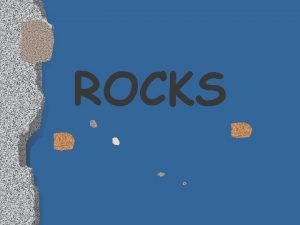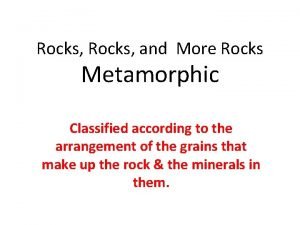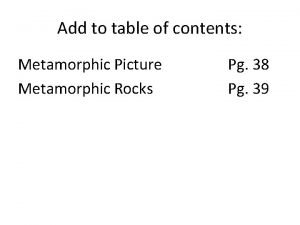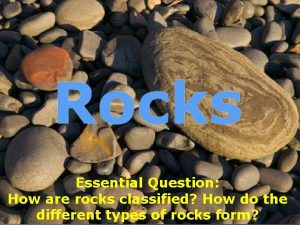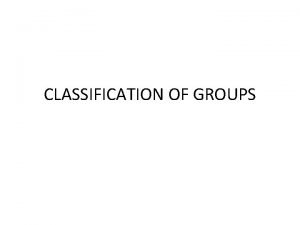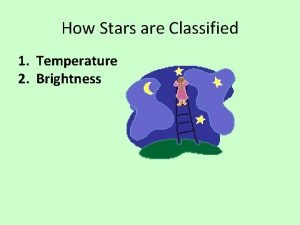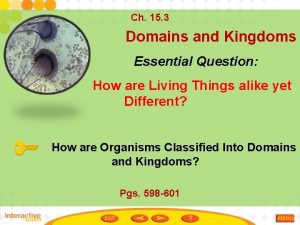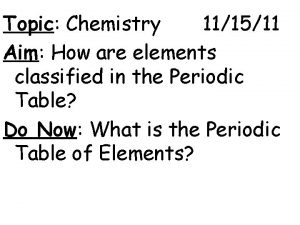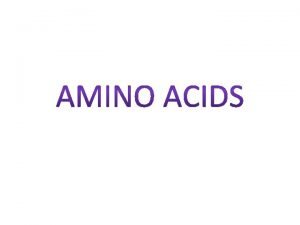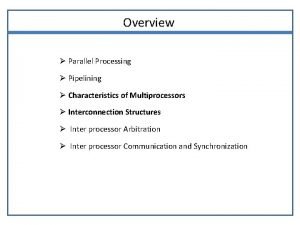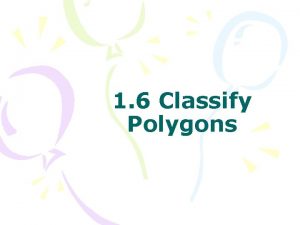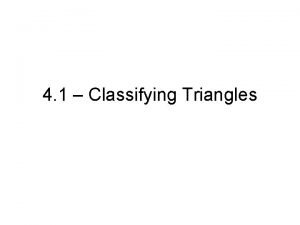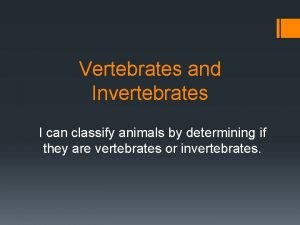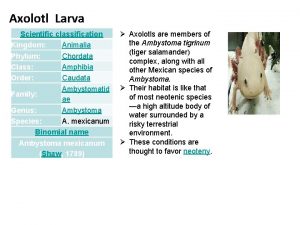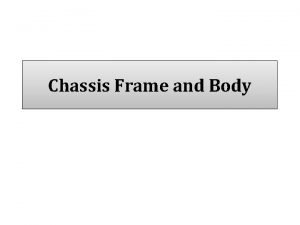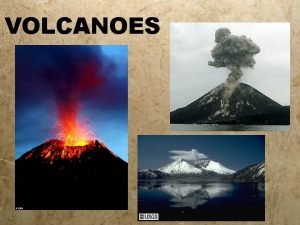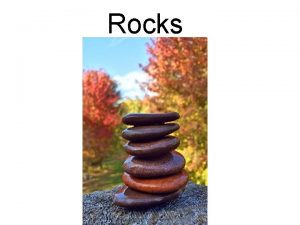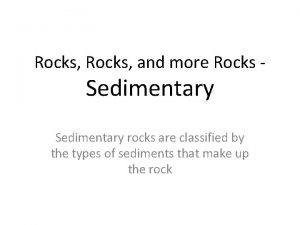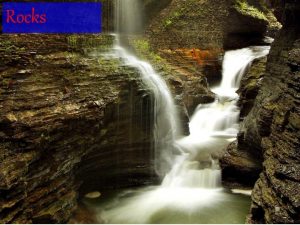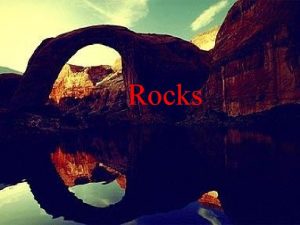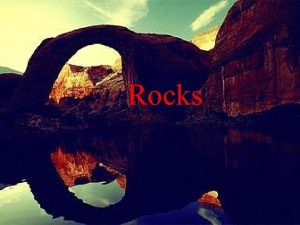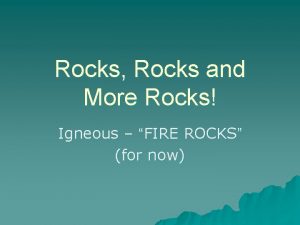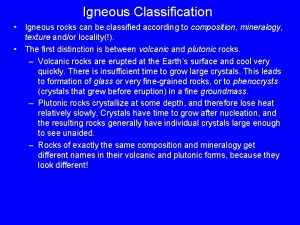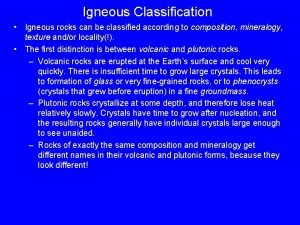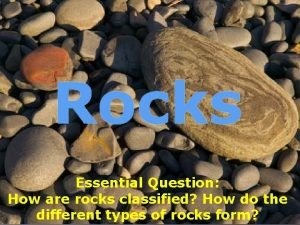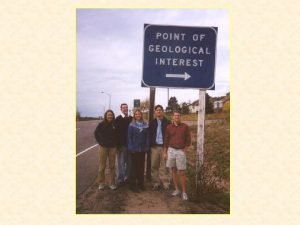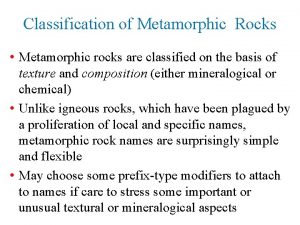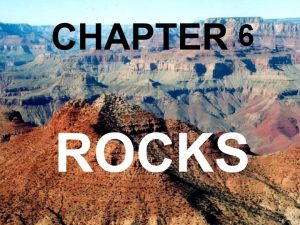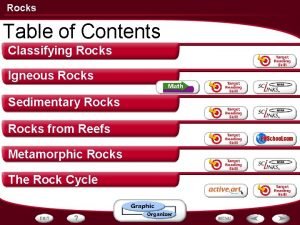ROCKS Are classified according to the environment in













































































- Slides: 77

ROCKS

Are classified according to the environment in which they _____ form

Types of Rocks: igneous ________ sedimentary ____ metamorphic

IGNEOUS ROCKS

Where Does Igneous Rock Form?

I. FORMATION OF IGNEOUS ROCKS

A. Igneous rocks form directly from the solidification _______ and crystallization _______

of _____molten liquid rock to form _______ solid rock

FOUNTAINING

FISSURE ERUPTION


LAVA FLOW


LAVA FLOW OVER A ROAD

LAVA FLOW THROUGH FORREST

Kilauea, HI 2003

Kilauea, HI , 2003


Mt. ST. Helens

Volcanic crater

crazy vulcanist

SKY LIGHT







crystallization B. _______ is the process when a liquid rock cools,

and it changes to a solid made of INTERGROWN CRYSTALS __________


GRANITE MICROSCOPIC VIEW

2. CLASSIFICATION OF IGNEOUS ROCKS:

A. 2 characteristics that are used to classify igneous rocks:

texture 1. _______ mineral composition 2. _______


B. Texture of an igneous rock describes the

_____, size _____ shape and arrangement ______ of the mineral crystals it was made from.

size C. The ______ of the crystals depends on the Rate of _______ cooling _____

Slow cooling = large crystals ______


MINERAL CRYSTALS

GABBRO

Fast cooling = fine crystals ______ Or no crystals (glassy)

GLASSY TEXTURE: OBSIDIAN

BASALT: FINE CRYSTALS

BASALT MICROSCOPIC VIEW

Granite: Coarse crystals Basalt: Fine crystals (Microscopic views)

FINE CRYSTAL: RYOLITE

3. EXTRUSIVE IGNEOUS ROCKS: Extrusions A. _______ occurs when molten (liquid) rock flows out of the earth as ________ lava

lava magma

And cools quickly _____

to form fine or no crystals ______

Vesicular basalt gas pockets

frothy texture (vesicular) This rock if full of gas pockets

B. To form magma, minerals ______ must be melted.

C. Minerals melt at different temperatures ______ pressures and ______

D. Igneous rocks of different composition ______

Can form from the same body of magma ______

4. INTRUSIVE IGNEOUS ROCKS: A. Intrusions _______ occurs when molten rock beneath the surface (magma)

cools slowly ______ to form coarse crystals _______

Granite: Coarse crystals Basalt: Fine crystals (Microscopic views)


5. FELSIC A. Igneous rocks of the continental crust are rich in _____ density _____ colored minerals (granitic) low light

6. MAFIC A. Igneous rocks of the ocean floor are rich in _____ density _____ colored minerals (basaltic) high dark


Comparing Oceanic Crust To Continental Crust

Continental Crust: 1. low density 2. light color 3. granitic 4. felsic 5. thick

Oceanic Crust: 1. high density 2. dark color 3. basaltic 4. mafic 5. thin

Complete the Activity Use this diagram in your ESRT to answer the following: What is the temperature for the interface between the following… inner core and outer core? 6250° C Outer core and stiffer mantle? 5000° C Stiffer Mantle and athenosphere? 2600° C Asthenosphere and lithosphere? 750° C

What is the depth of the interface between the stiffer mantle and the outer core? 2900 KM State the relationship between depth and pressure : As depth increase pressure increases State the relationship between depth and temperature: As depth increases temperature increases


MELTING ROCKS AND CRYSTALLIZING MAGMA Rock magma rock When rocks melt, bonds broken. Crystalline solid no longer exists.

MELTING ROCKS AND CRYSTALLIZING MAGMA Rock magma rock • Hot liquid contains still solid fragments • Minerals melt at different temperatures • Melting causes changes in magma composition

MELTING ROCKS AND CRYSTALLIZING MAGMA Rock magma rock • Cooling of hot liquid allows crystallization of minerals • Bonds are re-established • Crystalline structure grows until edges touch adjacent crystals • Minerals crystallize at different temperatures

OK………. . TAKE OUT YOUR REFERENCE TABLE

 Antigentest åre
Antigentest åre Rocks are classified according to
Rocks are classified according to Igneous and metamorphic
Igneous and metamorphic Igneous metamorphic sedimentary
Igneous metamorphic sedimentary Uses of metamorphic rocks
Uses of metamorphic rocks Confining pressure vs directed pressure
Confining pressure vs directed pressure Table of contents picture
Table of contents picture Wedcc
Wedcc Classification of tools and equipment
Classification of tools and equipment Traditional vowels
Traditional vowels Intrusive vs extrusive igneous rocks
Intrusive vs extrusive igneous rocks Naviance lasa
Naviance lasa Financial environment of business
Financial environment of business Công của trọng lực
Công của trọng lực Thế nào là mạng điện lắp đặt kiểu nổi
Thế nào là mạng điện lắp đặt kiểu nổi Tỉ lệ cơ thể trẻ em
Tỉ lệ cơ thể trẻ em Lời thề hippocrates
Lời thề hippocrates Các loại đột biến cấu trúc nhiễm sắc thể
Các loại đột biến cấu trúc nhiễm sắc thể Vẽ hình chiếu đứng bằng cạnh của vật thể
Vẽ hình chiếu đứng bằng cạnh của vật thể độ dài liên kết
độ dài liên kết Quá trình desamine hóa có thể tạo ra
Quá trình desamine hóa có thể tạo ra Môn thể thao bắt đầu bằng từ chạy
Môn thể thao bắt đầu bằng từ chạy Sự nuôi và dạy con của hươu
Sự nuôi và dạy con của hươu điện thế nghỉ
điện thế nghỉ Biện pháp chống mỏi cơ
Biện pháp chống mỏi cơ Trời xanh đây là của chúng ta thể thơ
Trời xanh đây là của chúng ta thể thơ Gấu đi như thế nào
Gấu đi như thế nào Thiếu nhi thế giới liên hoan
Thiếu nhi thế giới liên hoan Phối cảnh
Phối cảnh Một số thể thơ truyền thống
Một số thể thơ truyền thống Các châu lục và đại dương trên thế giới
Các châu lục và đại dương trên thế giới Thế nào là hệ số cao nhất
Thế nào là hệ số cao nhất Hệ hô hấp
Hệ hô hấp Tư thế ngồi viết
Tư thế ngồi viết Bảng số nguyên tố
Bảng số nguyên tố Hát kết hợp bộ gõ cơ thể
Hát kết hợp bộ gõ cơ thể đặc điểm cơ thể của người tối cổ
đặc điểm cơ thể của người tối cổ Cách giải mật thư tọa độ
Cách giải mật thư tọa độ Chụp tư thế worms-breton
Chụp tư thế worms-breton ưu thế lai là gì
ưu thế lai là gì Thẻ vin
Thẻ vin Cái miệng nó xinh thế
Cái miệng nó xinh thế Thơ thất ngôn tứ tuyệt đường luật
Thơ thất ngôn tứ tuyệt đường luật Các châu lục và đại dương trên thế giới
Các châu lục và đại dương trên thế giới Từ ngữ thể hiện lòng nhân hậu
Từ ngữ thể hiện lòng nhân hậu Bổ thể
Bổ thể Tư thế ngồi viết
Tư thế ngồi viết Diễn thế sinh thái là
Diễn thế sinh thái là Ng-html
Ng-html Ví dụ giọng cùng tên
Ví dụ giọng cùng tên 101012 bằng
101012 bằng Alleluia hat len nguoi oi
Alleluia hat len nguoi oi Khi nào hổ mẹ dạy hổ con săn mồi
Khi nào hổ mẹ dạy hổ con săn mồi đại từ thay thế
đại từ thay thế Vẽ hình chiếu vuông góc của vật thể sau
Vẽ hình chiếu vuông góc của vật thể sau Horton cooley classified groups
Horton cooley classified groups How are stars classified?
How are stars classified? Network security essentials 5th edition
Network security essentials 5th edition How are organisms classified into domains and kingdoms
How are organisms classified into domains and kingdoms How are elements classified
How are elements classified How are quick breads classified
How are quick breads classified Ud of classified information and cui
Ud of classified information and cui Amino acids classification
Amino acids classification Alcohol is classified as a
Alcohol is classified as a Time shared common bus
Time shared common bus Classifying polygons by sides
Classifying polygons by sides Highest level of classified information
Highest level of classified information Greedy channel routing classified under the type of:
Greedy channel routing classified under the type of: Simile, metaphor, hyperbole
Simile, metaphor, hyperbole How to classify a triangle by its coordinates
How to classify a triangle by its coordinates Vertebrates are classified as
Vertebrates are classified as Statement of financial position assets
Statement of financial position assets Taxonomy of axolotl
Taxonomy of axolotl Lesson 2 prokaryotes 1
Lesson 2 prokaryotes 1 What is frameless construction in automobile
What is frameless construction in automobile It is a large hanging barrel drum. *
It is a large hanging barrel drum. * Single instruction stream
Single instruction stream How are volcanoes classified
How are volcanoes classified

